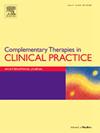Assessing barriers to meditation in patients with substance use disorder
IF 2.2
3区 医学
Q2 INTEGRATIVE & COMPLEMENTARY MEDICINE
引用次数: 0
Abstract
Background and purpose
Individuals living with substance use disorder (SUD) often face unique challenges that can hinder their engagement in beneficial practices like meditation, which has been shown to support recovery and well-being. This study aimed to explore the perceived barriers to meditation with SUD, identify key obstacles, and inform future interventions that promote the adoption of a personal practice.
Materials and methods
We conducted a cross-sectional analytic study with a convenience sample of participants attending a treatment center for SUD. Data collected included demographics, SUD history, health challenges, meditation knowledge, and previous meditation practice. Barriers to meditation were evaluated using the Determinants of Meditation Practice Inventory (DMPI) and its revised version, DMPI-R. Overall frequencies, proportions, and measures of central tendency were calculated. Participants currently practicing meditation were compared to those not meditating by using Fisher's exact test, Student's t-test, and Wilcoxon rank-sum test.
Results
One hundred sixteen individuals completed the survey. Survey respondents were an average of 45 years (standard deviation, SD, 11.46), majority female (67.0 %), and White (90.3 %). Only 28.7 % of respondents were informed of meditation by their healthcare provider, yet 81.7 % were interested in learning about meditation. Among survey respondents, “prayer is my form of meditation,” followed by “I can't stop my thoughts,” were most agreed upon.
Conclusion
Individuals living with SUD are interested in education on meditation techniques; however, additional research is needed to understand the determinants of meditation practice and discern the barriers that could help facilitate the adoption and long-term practice of this method.
求助全文
约1分钟内获得全文
求助全文
来源期刊

Complementary Therapies in Clinical Practice
INTEGRATIVE & COMPLEMENTARY MEDICINE-
CiteScore
6.30
自引率
6.70%
发文量
157
审稿时长
40 days
期刊介绍:
Complementary Therapies in Clinical Practice is an internationally refereed journal published to meet the broad ranging needs of the healthcare profession in the effective and professional integration of complementary therapies within clinical practice.
Complementary Therapies in Clinical Practice aims to provide rigorous peer reviewed papers addressing research, implementation of complementary therapies (CTs) in the clinical setting, legal and ethical concerns, evaluative accounts of therapy in practice, philosophical analysis of emergent social trends in CTs, excellence in clinical judgement, best practice, problem management, therapy information, policy development and management of change in order to promote safe and efficacious clinical practice.
Complementary Therapies in Clinical Practice welcomes and considers accounts of reflective practice.
 求助内容:
求助内容: 应助结果提醒方式:
应助结果提醒方式:


